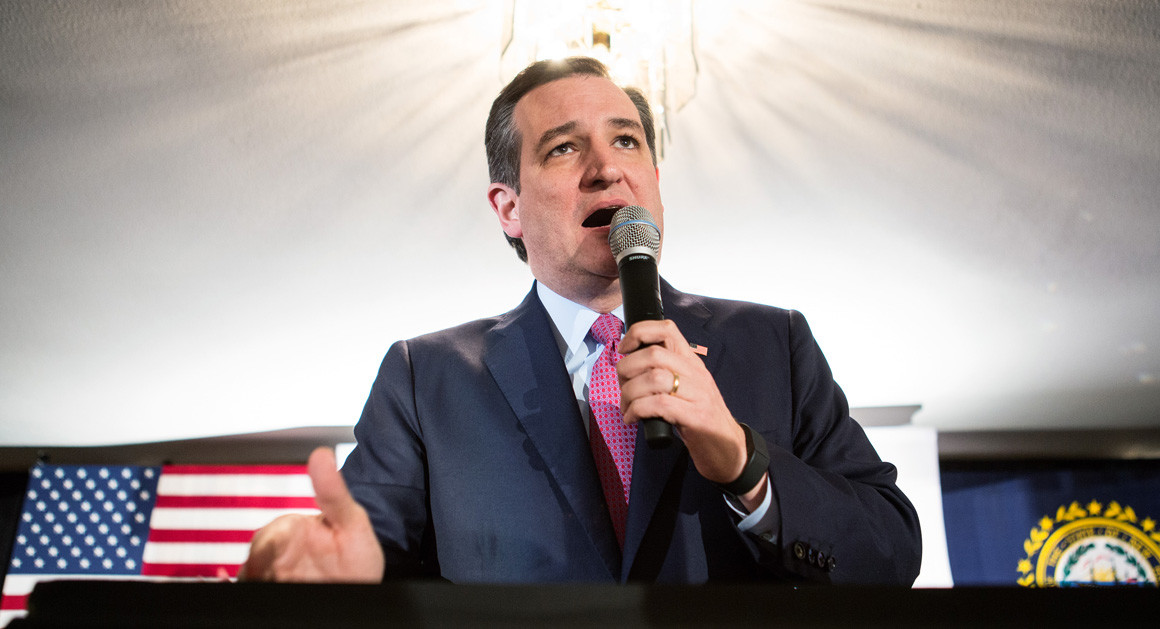
Four months ago, Ted Cruz blasted his fellow lawmakers for reaching a bipartisan budget deal that “completely annihilates” Congress’ self-imposed spending limits, calling the caps “the one successful attempt at spending restraint in the Obama era.”
Now the Republican presidential hopeful is pushing for 50,000 more Army soldiers, more than 75 new Navy warships and nearly 500 additional Air Force planes, a military buildup that would blow through those spending limits by hundreds of billions of dollars. And even conservative analysts say he can't have it both ways.
The Texas senator, who came to prominence by forcing a government shutdown over a budget dispute in 2013, hasn’t estimated a price tag for the defense vision he laid out this week, in advance of Saturday’s primary in military-heavy South Carolina. But one centrist think tank says his proposals would cost roughly $140 billion more each year than the Obama administration’s current blueprint.
Some conservative defense experts say the yawning gap between Cruz’s defense visions and the nation’s budget picture is even wider than that — thanks to the same budget caps he extols as a tool for fiscal discipline, as well as Democrats’ certain resistance to taking an ax to domestic spending or entitlements.
Cruz’s plan “certainly doesn’t seem particularly informed by political realities,” said Benjamin Friedman, a fellow at the libertarian-leaning Cato Institute.
Mackenzie Eaglen, a defense analyst at the conservative American Enterprise Institute, said whoever occupies the White House in 2017 will already face a roughly $250 billion shortfall in defense spending, due to the tight grip of the spending caps and the hundreds of billions of dollars it will cost to modernize the U.S. nuclear fleet that the Pentagon has not budgeted for.
“That’s before you buy one new ship, one new aircraft and one new soldier,” said Eaglen, who has briefed several GOP 2016 candidates.
Cruz’s defense plan stresses the need for spending cuts on the one hand while calling for more ships and soldiers on the other. He calls for an Army of 525,000 active-duty soldiers, reversing a drawdown that puts the service on a path to 475,000 at the end of this fiscal year, and a Navy of 350 ships, up from today’s 272.
He also wants the Air Force fleet to rise to 6,000 aircraft, including 1,500 tactical fighter aircraft.
The increases would total roughly an additional $140 billion in defense spending above the Obama administration’s $610 billion national defense budget for fiscal 2017, according to Mark Cancian, a senior adviser with the centrist Center for Strategic and International Studies, who ran Cruz’s proposal through the think tank’s “force-cost calculator.”
Cruz's campaign did not respond to a request for comment.
In his speech Tuesday in South Carolina, he said he could offset the cost of his added military spending by accelerating economic growth at a 4- to 5-percent clip, selling federal assets and land, and cutting other spending by $500 billion — including waste and duplication at the Pentagon.
But don’t expect the Democrats to go along with that, Friedman said. “Even with a Republican Congress, the basic dynamics that have restrained defense spending are still going to be in place,” he said. “And Democrats are not going to be so enfeebled that they can’t stop anything.”
Other Republican candidates have laid out similar goals for the military as Cruz, though not all have released the same level of specifics.
Former Florida Gov. Jeb Bush wants to boost the defense budget by $1 trillion over 10 years compared with the levels envisioned under the Budget Control Act of 2011. Ohio Gov. John Kasich is calling for $102 billion in additional defense spending over eight years. And Florida Sen. Marco Rubio wants a 323-ship Navy with an additional aircraft carrier.
Cruz, however, has tried to walk the line between being a defense hawk and a budget hawk as he mounts his bid. The two Republican factions have battled on Capitol Hill over the federal budget, with many fiscal hawks cheering on the budget cuts to the Pentagon as real reductions of federal spending.
His record on national security has come under fire in the presidential campaign. Rubio has criticized the Texas senator’s votes against the National Defense Authorization Act, which authorizes funding for the Pentagon, as well as his support for a budget from Sen. Rand Paul (R-Ky.) that would have slowed defense spending.
At the same time, Cruz supported an amendment from Rubio himself last year that would have boosted defense spending by hundreds of billions over the next decade.
But Cruz’s detailed proposal for defense is the latest example of his attempt to appeal both to fiscal conservatives and hawks who support a more muscular foreign policy — while ignoring the inherent contradiction between the GOP's factions.
The biggest challenge he or any other Republican president would face is that the Budget Control Act — which limits both defense and non-defense discretionary spending — kicks back into effect next fall unless Congress acts to change the spending limits.
Even the Obama administration’s budget, which Republicans say is decimating the military, includes $100 billion more than the spending caps allow over the next five years.
Eaglen said that Cruz and other presidential hopefuls who are proposing massive increases in defense spending are in for a shock.
“I don’t think the candidates themselves know what they’re in for," she said. "But this is the budget math, and it ain’t pretty.”
- Publish my comments...
- 0 Comments
